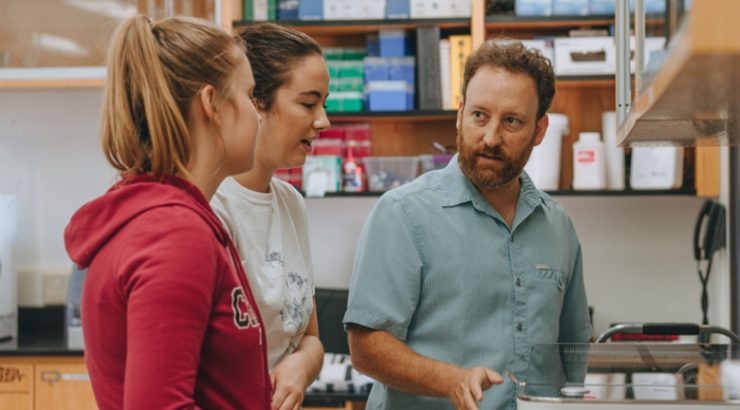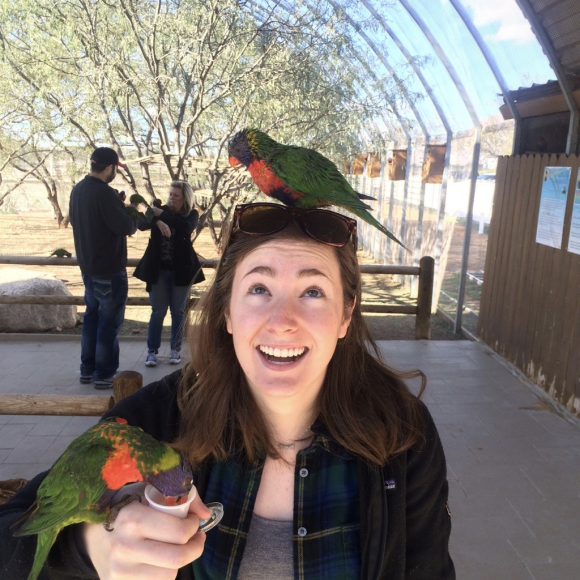
Five Schmid Faculty Win Grant Writers’ Bootcamp Awards Learn more about the research the grant supports
November 30, 2020
At this year’s second annual Grant Writers’ Bootcamp, Schmid College was excited to be represented by five faculty members who received $4,000 each in seed funding from the Office of Research in support of their research proposals.
The Grant Writers’ Bootcamp is an annual event designed to help faculty enhance their grant writing capabilities. At the event, participants attend workshops and virtual collaborative working groups, all of which are guided by faculty mentors and guest speakers with experience writing and winning grant awards. By the end of the event, they submit proposals for seed funding. On September 4, 2020, the Office of Research selected five faculty members from Schmid College to receive funding.
Congratulations to Dr. Bill Wright, Dr. Brian Hoover, Dr. Aaron Harrison, Dr. Brenna Gormally, and Dr. Patricia Lopes!
We checked in with some of the faculty to see what they are currently working on with the grant from the Office of Research.

Dr. Brenna Gormally (Grand Challenges Initiative Postdoctoral Fellow)
“As a postdoctoral fellow and an early career researcher, the Grant Writers’ Bootcamp was really an invaluable opportunity. The grant writing process can be really intimidating and it was wonderful to delve into it over two full days. In particular, it was great to have the opportunity to get direct feedback on my research ideas from colleagues. With this funding, I [am] conducting a small pilot study to test the effects of short-term stressors on Japanese quail. While we often think about “stress” as a bad thing, the short-term stress response is actually crucial for coping with unpredictable events in their environments. My research seeks to understand the tradeoffs between these short-term responses and the consequences of chronic stress.”
 Dr. Aaron Harrison (Grand Challenges Initiative Postdoctoral Fellow)
Dr. Aaron Harrison (Grand Challenges Initiative Postdoctoral Fellow)
“Atmospheric aerosols have a significant impact on air quality and subsequently human health. In addition, they influence radiative forcing in the climate i.e. how much energy from the sun is absorbed in the atmosphere. Physical scattering of sunlight by aerosols has a cooling impact on the atmosphere while chemical absorption leads to a warming effect. The compounds in aerosols that absorb in the near UV and visible parts of the solar spectrum are collectively known as brown carbon (BrC), and their overall impact on the global radiation budget remains a large uncertainty in climate modelling. To better understand the chemical and optical properties of brown carbon, the proposed research will undertake laboratory synthesis of brown carbon mimics from common atmospheric aerosol precursors and use advanced spectroscopic techniques to study the photochemistry and molecular composition of these samples.”
 Dr. Brian Hoover (Grand Challenges Initiative Postdoctoral Fellow)
Dr. Brian Hoover (Grand Challenges Initiative Postdoctoral Fellow)
“Here at Chapman University, Dr. Walter Piper has been collecting behavioral data on Common Loons in northern Wisconsin since 1993 (loonproject.org). This data record allows us to investigate long-term trends in the loon population. Because the loon project routinely monitors loons on about 200 lakes, I’m interested in how recent habitat shifts explain some loon patterns in reproductive success. In particular, I can look at shifts in shoreline vegetation and spring ice cover from current and historic satellite data, and ask how recent changes in these variables might relate to patterns in the loon population and their behavior. The Grant Writer’s Bootcamp funding enables me to work with students to undertake GIS (Geographic Information Systems) projects to help investigate these relationships.”
 Dr. Bill Wright (Associate Professor; Biological Sciences)
Dr. Bill Wright (Associate Professor; Biological Sciences)
“[The proposal] was motivated by the realization that the earth’s oceans are relatively rapidly becoming acidified by anthropogenically mediated increase in carbon dioxide in the earth’s atmosphere. This is a profoundly alarming consequence of the CO2 emissions from our industrial world…. But perhaps the most interesting, and troubling, finding of the 2010s is that OA can compromise the ability of many organisms, both vertebrates and invertebrates, to detect the chemical signal of their predators and avoid or defend themselves. Settling larval fish depend on detecting predator signals when avoiding predator-rich reefs. Interestingly, invertebrate anti-predator behavior can also be compromised. For example, Ali Sidun, a Chapman undergraduate, showed a couple of years ago that anti-predator vigilance is completely abolished in slightly acidic water.
An interesting hypothesis for the neural basis for this behavior was published about 5 years ago now, and my proposal that was funded by the grant writer’s boot camp seeks to test this hypothesis. We will take advantage of the exceedingly rich literature on the neural basis of behavior in a mollusk, the sea hare, Aplysia californica. I have studied the neurobiology of this species for many years and am truly looking forward to testing the hypothesis. We will be performing neurobiological experiments in the coming months to see if our approach to testing the ionic hypothesis for OA-mediated compromise of predator detection has promise. This is going to be a ton of fun, and if we strike gold, we will significantly advance our understanding of the future oceans as they become more and more acidic.”
Dr. Patricia Lopes (Assistant Professor; Biological Sciences)
Her research title is “the transgenerational effects of high disease risk.” Dr. Lopes was not available for a quote.
Cover Photo: Brian Hoover working with students from the Grand Challenges Initiative.

